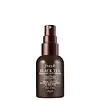What's inside
What's inside
 Key Ingredients
Key Ingredients

 Benefits
Benefits

 Concerns
Concerns

 Ingredients Side-by-side
Ingredients Side-by-side

Cyclopentasiloxane
EmollientWater
Skin ConditioningIsostearyl Palmitate
EmollientPolyethylene
AbrasiveButylene Glycol
HumectantPolysilicone-11
Ethylene/Acrylic Acid Copolymer
Emulsion StabilisingMorus Bombycis Root Extract
Skin ConditioningCaffeine
Skin ConditioningPhytosphingosine
Skin ConditioningTriticum Vulgare Bran Extract
Skin ConditioningScutellaria Baicalensis Root Extract
AstringentLactis Proteinum
Skin ConditioningOlea Europaea Fruit Extract
BleachingCamellia Sinensis Leaf Extract
AntimicrobialCholesterol
EmollientLinoleic Acid
CleansingTocopheryl Acetate
AntioxidantMagnesium Ascorbyl Phosphate
AntioxidantPyridoxine Dipalmitate
Skin ConditioningSucrose
HumectantGlycerin
HumectantDimethicone
EmollientGlyceryl Laurate
EmollientPEG/PPG-18/18 Dimethicone
EmulsifyingPetrolatum
EmollientCetyl PEG/PPG-10/1 Dimethicone
EmulsifyingPropylene Carbonate
SolventSodium Chloride
MaskingQuaternium-90 Bentonite
Disodium EDTA
Phenoxyethanol
PreservativeIron Oxides
Cyclopentasiloxane, Water, Isostearyl Palmitate, Polyethylene, Butylene Glycol, Polysilicone-11, Ethylene/Acrylic Acid Copolymer, Morus Bombycis Root Extract, Caffeine, Phytosphingosine, Triticum Vulgare Bran Extract, Scutellaria Baicalensis Root Extract, Lactis Proteinum, Olea Europaea Fruit Extract, Camellia Sinensis Leaf Extract, Cholesterol, Linoleic Acid, Tocopheryl Acetate, Magnesium Ascorbyl Phosphate, Pyridoxine Dipalmitate, Sucrose, Glycerin, Dimethicone, Glyceryl Laurate, PEG/PPG-18/18 Dimethicone, Petrolatum, Cetyl PEG/PPG-10/1 Dimethicone, Propylene Carbonate, Sodium Chloride, Quaternium-90 Bentonite, Disodium EDTA, Phenoxyethanol, Iron Oxides
Water
Skin ConditioningGlycerin
HumectantButylene Glycol
HumectantPentylene Glycol
Skin ConditioningJojoba Oil PEG-150 Esters
Skin ConditioningMethyl Gluceth-20
HumectantPEG-6 Caprylic/Capric Glycerides
EmulsifyingAcacia Senegal Gum
MaskingPEG-40 Hydrogenated Castor Oil
EmulsifyingLycium Chinense Fruit Extract
AntioxidantSaccharomyces Ferment Filtrate
HumectantCamellia Sinensis Leaf Extract
AntimicrobialRubus Fruticosus Leaf Extract
MaskingLitchi Chinensis Seed Extract
Skin ConditioningAcetyl Tetrapeptide-5
HumectantTocopheryl Acetate
AntioxidantTocopherol
AntioxidantPolymethylsilsesquioxane
Carbomer
Emulsion StabilisingPEG-150
HumectantSorbitol
HumectantSodium Hydroxide
BufferingParfum
MaskingRhizobian Gum
Maltodextrin
AbsorbentAlgin
MaskingXanthan Gum
EmulsifyingAdenosine
Skin ConditioningPolyvinyl Alcohol
Cellulose Gum
Emulsion StabilisingCitric Acid
BufferingSodium Metabisulfite
AntioxidantDiamond Powder
AbrasiveSodium Benzoate
MaskingPotassium Sorbate
PreservativeHydroxyethylcellulose
Emulsion StabilisingSodium Citrate
BufferingBiotin
AntiseborrhoeicPhenoxyethanol
PreservativeLinalool
PerfumingCitronellol
PerfumingGeraniol
PerfumingWater, Glycerin, Butylene Glycol, Pentylene Glycol, Jojoba Oil PEG-150 Esters, Methyl Gluceth-20, PEG-6 Caprylic/Capric Glycerides, Acacia Senegal Gum, PEG-40 Hydrogenated Castor Oil, Lycium Chinense Fruit Extract, Saccharomyces Ferment Filtrate, Camellia Sinensis Leaf Extract, Rubus Fruticosus Leaf Extract, Litchi Chinensis Seed Extract, Acetyl Tetrapeptide-5, Tocopheryl Acetate, Tocopherol, Polymethylsilsesquioxane, Carbomer, PEG-150, Sorbitol, Sodium Hydroxide, Parfum, Rhizobian Gum, Maltodextrin, Algin, Xanthan Gum, Adenosine, Polyvinyl Alcohol, Cellulose Gum, Citric Acid, Sodium Metabisulfite, Diamond Powder, Sodium Benzoate, Potassium Sorbate, Hydroxyethylcellulose, Sodium Citrate, Biotin, Phenoxyethanol, Linalool, Citronellol, Geraniol
 Reviews
Reviews

Ingredients Explained
These ingredients are found in both products.
Ingredients higher up in an ingredient list are typically present in a larger amount.
Butylene Glycol (or BG) is used within cosmetic products for a few different reasons:
Overall, Butylene Glycol is a safe and well-rounded ingredient that works well with other ingredients.
Though this ingredient works well with most skin types, some people with sensitive skin may experience a reaction such as allergic rashes, closed comedones, or itchiness.
Learn more about Butylene GlycolCamellia Sinensis Leaf Extract is derived from the leaves of the tea plant. Black tea, green tea, and oolong tea are all harvested from this plant.
This ingredient has many skin benefits:
This ingredient contains polyphenols, a strong antioxidant. Antioxidants help fight off molecules that damage skin cells.
On top of that, the antioxidants in green tea neutralize free-radicals from the sun. This gives the skin some extra UV protection, but should not replace sunscreen.
Many components of tea have anti-inflammatory properties.
Polyphenols and L-theanine help soothe the skin and reduce irritation. The caffeine in Camellia Sinensis Leaf Extract helps calm inflamed blood vessels.
Other compounds found in tea include: Vitamin Bs, linoleic acid, magnesium, calcium, iron, and zinc.
Research has shown both drinking Camellia Sinensis Leaf Tea and applying it to the skin can help boost skin elasticity and hydration. Studies also show using tea extract may reduce sebum, or oil, production.
Learn more about Camellia Sinensis Leaf ExtractGlycerin is already naturally found in your skin. It helps moisturize and protect your skin.
A study from 2016 found glycerin to be more effective as a humectant than AHAs and hyaluronic acid.
As a humectant, it helps the skin stay hydrated by pulling moisture to your skin. The low molecular weight of glycerin allows it to pull moisture into the deeper layers of your skin.
Hydrated skin improves your skin barrier; Your skin barrier helps protect against irritants and bacteria.
Glycerin has also been found to have antimicrobial and antiviral properties. Due to these properties, glycerin is often used in wound and burn treatments.
In cosmetics, glycerin is usually derived from plants such as soybean or palm. However, it can also be sourced from animals, such as tallow or animal fat.
This ingredient is organic, colorless, odorless, and non-toxic.
Glycerin is the name for this ingredient in American English. British English uses Glycerol/Glycerine.
Learn more about GlycerinPhenoxyethanol is a preservative that has germicide, antimicrobial, and aromatic properties. Studies show that phenoxyethanol can prevent microbial growth. By itself, it has a scent that is similar to that of a rose.
It's often used in formulations along with Caprylyl Glycol to preserve the shelf life of products.
Tocopheryl Acetate is AKA Vitamin E. It is an antioxidant and protects your skin from free radicals. Free radicals damage the skin by breaking down collagen.
One study found using Tocopheryl Acetate with Vitamin C decreased the number of sunburned cells.
Tocopheryl Acetate is commonly found in both skincare and dietary supplements.
Learn more about Tocopheryl AcetateWater. It's the most common cosmetic ingredient of all. You'll usually see it at the top of ingredient lists, meaning that it makes up the largest part of the product.
So why is it so popular? Water most often acts as a solvent - this means that it helps dissolve other ingredients into the formulation.
You'll also recognize water as that liquid we all need to stay alive. If you see this, drink a glass of water. Stay hydrated!
Learn more about Water